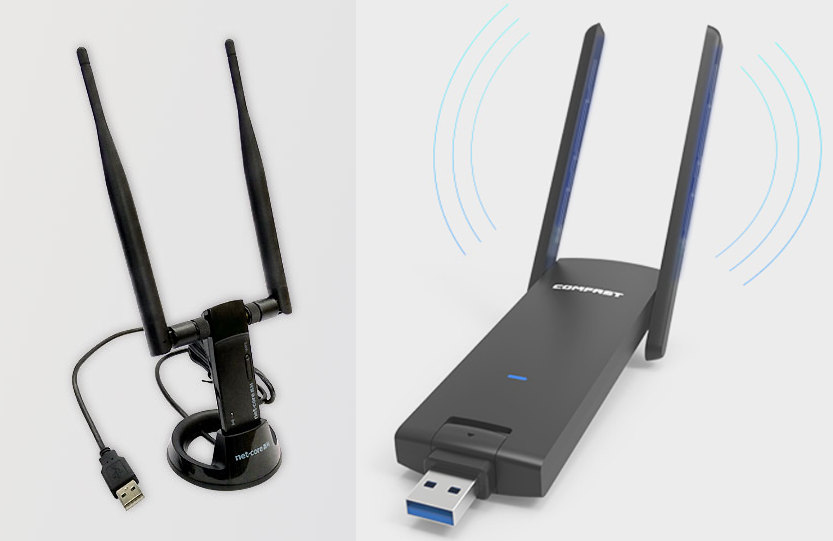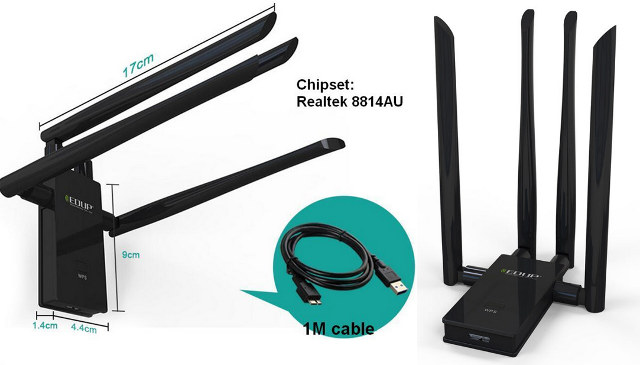When last week I reviewed Rock64 board I noticed they sold a “USB 3.0 Dual Band 1200Mbps WIFI 802.11 a/b/g/n/ac (RTL8812AU) adapter” for $19.99. So far I had only seen USB dongles with internal antennas or a single external antenna, but in the case of development boards, which may be used as routers or gateways, it makes perfect sense to get such adapter for higher performance and longer range. The only problem is that it “ships together with ROCK64 fulfillment”, meaning you can’t purchase it separately if you already have some other board to use, so I went to look for alternatives.

One of the first I’ve come across was COMFAST CF-926AC with the following specifications:
- Chipset – Mediatek MT7612U
- Interface – USB 3.0 rotatable port
- WiFi – Dual band 2T2R WiFi 802.11ac, 802.11a, 802.11b, 802.11g, 802.11n up to “1200” Mbps (867 Mbps @ 5.8 GHz + 300 Mbps @ 2.4 GHz)
- Antenna – 2x external high gain (3dBi) antennas (270° rotation)
- Dimensions – 19.50 x 5.00 x 1.40 cm
- Weight – 410 grams
The page description mentions it works without drivers on Windows, but one seller reports that “it can support win10 system receive wifi signal,but it can’t support win10 system emission wifi signal”. As usual, no mention of Linux, but luckily a quick search found MT7612U Linux driver with support for AP and STA mode, just don’t run iwconfig in AP mode… It requires Linux 4.2 or greater, and as only been tested on x86_64 so far, so your mileage may vary on other targets.
I first found it on Aliexpress for $16.99 shipped, but you’ll also find it on GearBest for $15.99, and Amazon US for $19.99.

During my search I also found EDUP EP-AC1621 USB 3.0 WiFi adapter with four external antennas and the following specifications:
- Chipset – Realtek RTL8814AU
- Interface – USB 3.0 OTG port
- WiFi – Dual band WiFi 802.11ac, 802.11a, 802.11b, 802.11g, 802.11n up to 1900 Mbps (1300 Mbps @ 5.8 GHz + 600 Mbps @ 2.4 GHz)
- Antenna – 4x external high gain (6dBi) antennas
- Misc – WPS key
- Dimensions – 9.0 x 4.4 x 1.4 cm (body); 17 cm long antennas
The device does not connect directly to the USB port, but instead via a one meter USB 3.0 OTG to USB 3.0 type A cable. The description explains it comes with an “easy to use CD setup wizard and compatible with Microsoft Windows XP/VISTA/Win7/8.1/10 Linux/Macintosh”. In case, you’d rather have an alternative driver, you’ll find an 8814AU Linux driver in Github based on the original driver for Linux kernels up to 4.8 with DKMS support, but there are some commits to make it work with newer kernels.
I found that model on Aliexpress for $41.90, but again you can also purchase it on Amazon US or GearBest (and other sites).You may learn a little more by visiting the manufacturer’s product page.
Various other models are also sold, the important is to check whether the chipset is supported by your operating system, and if it supports the modes (AP, STA, AP+STA) required for your use case. Those type of adapters only really make sense with boards and devices with USB 3.0 interfaces, since USB 2.0 is limited to 480 Mbps.

Jean-Luc started CNX Software in 2010 as a part-time endeavor, before quitting his job as a software engineering manager, and starting to write daily news, and reviews full time later in 2011.
Support CNX Software! Donate via cryptocurrencies, become a Patron on Patreon, or purchase goods on Amazon or Aliexpress




